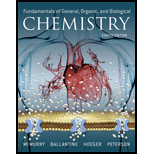
Interpretation:
The symbol of the ion when the Sulfur atom loses two electrons while reacting to be predicted.
Concept Introduction:
Formation of ions:
Atom possesses equal number of protons and electrons and remains electrically neutral. By gaining (accepting electrons) or losing (donating electrons) one or more electrons, converts the neutral atom into a charged particle called IONS.
Cation: The loss of one or more electrons by a neutral atom leaves the atom positively charged called cation.
Anion: The gain of one or more electrons by a neutral atom leaves the neutral atom negatively charged called anion.
The symbolic representation of ions:
The electrons are reside in the principal quantum number ‘n’; by losing and gaining electron, reduces and increases in the electron count in the electronic configuration of the atom; for a cation adding positive charge as a superscript to the symbol of the element and for the anion adding negative charge as superscript to the symbol of the element.
Want to see the full answer?
Check out a sample textbook solution
Chapter 3 Solutions
Pearson eText Fundamentals of General, Organic, and Biological Chemistry -- Instant Access (Pearson+)
- H₂C-C Ö: CH2 H3C — с O CH₂ + Clear The Lewis structure of acetone enolate ion, which has one other resonance structure, is shown. Complete the resonance structure by dragging bonds, charges, and electron lone pairs to their appropriate positions. Then check your answer.arrow_forwardWith the given structures, arrange the following compounds in order of decreasing reactivity towards hydrolysisarrow_forwardUnshared, or lone, electron pairs play an important role in determining the chemical and physical properties of organic compounds. Thus, it is important to know which atoms carry unshared pairs. Use the structural formulas below to determine the number of unshared pairs at each designated atom. Be sure your answers are consistent with the formal charges on the formulas. H₂C H₂ b Hc N CH2 The number of unshared pairs at atom a is The number of unshared pairs at atom b is The number of unshared pairs at atom c is The number of unshared pairs at atom a is 1 v The number of unshared pairs at atom b is Ov The number of unshared pairs at atom c is 1.arrow_forward
- (please type answer no write by hend).arrow_forwardChange the structure in the drawing area to show the aldonic acid product formed if the compound is easily oxidized. If there are no changes to be made, check the No changes box under the drawing area. No changes × CH₂OH C: H -OH H -OH H -OH снонarrow_forwardIdentify all of the chirality centers in the structure. The chirality centers are: A В C D `NH E F OH b H Он I J K L M N P Q Rarrow_forward
- Balance these chemical equations. (Use the lowest possible whole number coefficients.) (d) NH3 + O2 → NO2 + H2O(e) Fe(OH)2 + O2 + H2O → Fe(OH)3 (f) P2H4 → PH3 + P4arrow_forwardSolid iron(II) fluoride (FeF2, Ksp= 2.36 x 10-6) is dissolved in water. If 8.1 x 10-3 mol L-1 of iron(II) ion is found to be in solution. Is the solution saturated, unsaturated, desaturated or supersaturated.arrow_forwardConsider the following acids and their ionization constant, determine which conjugate base is HCOOH Ka = 1.7 x 10-4 (b) HCN Ka = 4.9 x 10-10arrow_forward
- Are these two compounds isomers? Explain. [Section 2.9]arrow_forwardDetermine the chemical formula for the following molecules by counting the Carbon, Hydrogen and Oxygen atoms. Determine if the molecule is a carbohydrate by checking the ratio of atoms. 5. Ho C 1 H-C-OH H-C-OH H-C-OH CH₂OH 6. CH₂OH HO-C=0 [ H-C-OH H-C-OH 1 H-C-DH I H - COH I H-C-H I H Chemical formula Carbohydrate ? Chemical formula Carbohydrate ?arrow_forwardHistidine has three ionizable groups. On the titration curve below, show: a) 2 molar equivalents of OH b) pka of the third ionizable group Histidine Titration 12.0 10.0 8.0 4 pH 6.0 4.0 2.0 0.0 Equivalents OHarrow_forward
